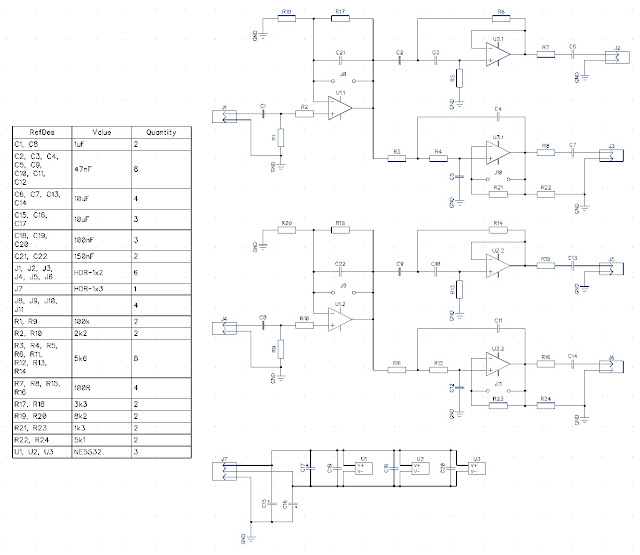The 3-Way Classic Part 6.
An active second order Linkwitz-Riley crossover. Rod Elliott got everything you need, as usual. Note that Rod is inverting the high-pass output buffer. I guess the crossover is intended for a two-way but inverting the HF branch in the active filter might not be a good idea for a three-way with a passive second order filter between the mid-range and the tweeter.
I was playing with the idea of boosting the woofer a bit in previous post. Either by a shelving low-pass with a center frequency of 383 Hz (the baffle step frequency for a 30 cm baffle), or by amplifying the whole LF branch. I made the following simulations in TINA-TI to compare the two.
The simulation got three voltage pins. BSC to measure the baffle step correcting filter at IOP1 enabled by opening JUMPER1. HP to measure the high-pass branch and LP to measure the low-pass branch. Amplification of the high pass branch can be enabled by opening the JUMPER2. Gain is set to 3 dB in both the baffle step correcting filter and the low-pass gain (to make it easier to compare the two). Rod is using trim-pots for gain adjustments on the output buffer. Great flexibility but a bit fidgety to adjust. But sometimes a couple of fixed values for a known boos might be enough. Easy to enable or disable and easy to channel match.
This is what the response looks like with both jumpers enabled. I have put a cursor at 600 Hz (the crossover frequency) and at 383 Hz (the baffle step frequency) as a reference between the different options. In this case we are 6 dB down at 600 Hz as expected, 3 dB down at 383 Hz and unity gain all over the board.
Opening up JUMPER1 enables the baffle step compensation circuit and this is the result. The LP and HP branches still intersect around 600 Hz but with a 1 dB boost. The boost at 383 Hz is around 1.5 dB.
Close JUMPER1 and open JUMPER2 to enable amplification of the whole LP branch and this is the result. The intersection of the LP and HP branches are moved up in frequency a bit. The LP branch is only down 4 dB at 600 Hz and the boost at 383 Hz is around 1.6 dB.
Both solutions are easy and cheap to implement. The actual boost can be set lower or higher than 3 dB just by replacing a couple of resistors with different values. I personally prefer the baffle step correcting circuit since it keeps the intersection of the LP and HP branches around the intended crossover point. It is also preventing the boosted woofer from blending as much with the mid-range. But it is all about preferences and the kind of target the builder is aiming for. I see two options with this build. Either aim for maximum SPL for the HP branch and use the active filter to boost the LP branch a bit. Or attenuate the HP branch to get maximum flat response and use room gain to boost the LP branch with no need for any extra gain in the active filter. The first option might not be as flat and the second not as sensitive.
As for the circuit, Rod Elliott got everything you need covered in his Project 81. Note the options of the output buffers. Figure 2 got variable gain on the HP branch and phase reversal of the LP branch. This is probably intended for a sat-sub speaker system. Figure 3 is inverting the HP branch with variable gain on the LP branch. Probably intended for a two-way system. We got a passive second order filter between the mid-range and the tweeter so inverting the HP branch makes less sense in this case. The variable gain buffer is a great option but quite fidgety when implemented with trim-pots.
I put together the following circuit heavily inspired by Rods. I skipped the separate output buffers (but kept the output resistor and capacitor). I added a baffle step compensation network to the input buffers feedback loop. It is enabled by opening the jumpers J8/J9 with a maximal gain of 2.85 dB (up 1.46 dB at 383 Hz). The whole LP branch can be boosted 2 dB by opening the jumpers J10/J11. Short jumpers J8/J9/J10/J11 for unity gain or replace them with links and omit components C21/C22/R17/18/R19/R20/R21/R22/R23/R24 altogether if not needed. The op-amps does not have to be NE5532 but they are unity gain stable, cheap and sounds great.
This marks the end of the sixth part about my 3-Way Classics. Time to order some parts, etch, drill and solder...











